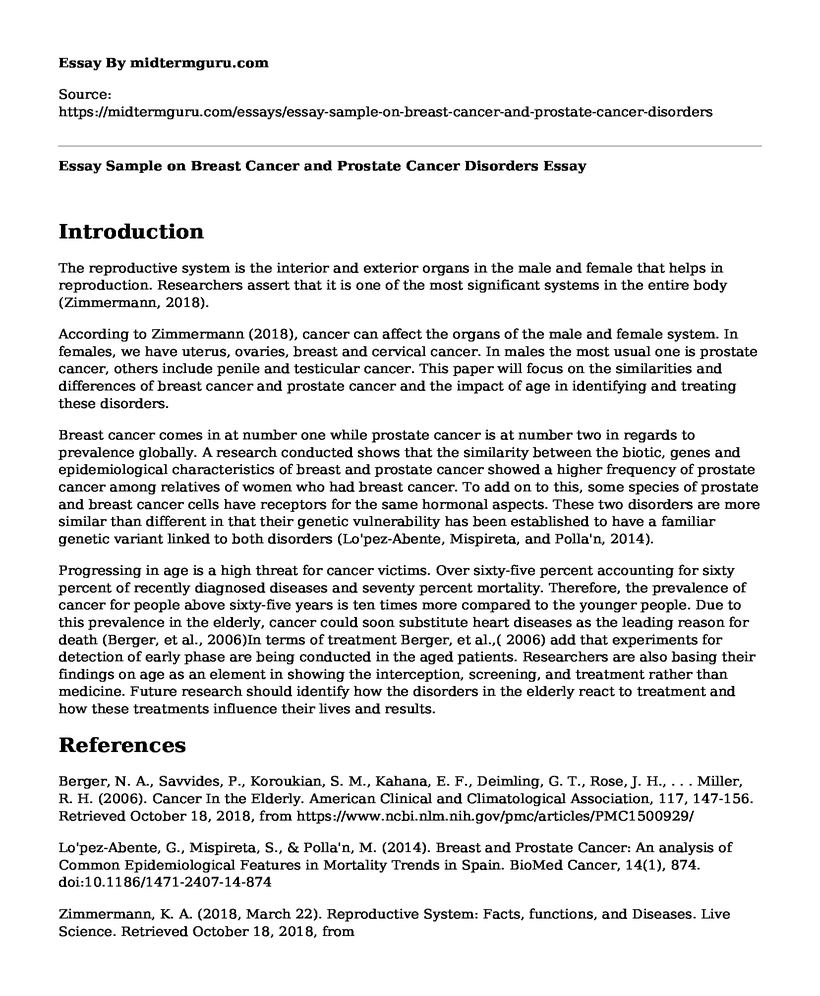Introduction
The reproductive system is the interior and exterior organs in the male and female that helps in reproduction. Researchers assert that it is one of the most significant systems in the entire body (Zimmermann, 2018).
According to Zimmermann (2018), cancer can affect the organs of the male and female system. In females, we have uterus, ovaries, breast and cervical cancer. In males the most usual one is prostate cancer, others include penile and testicular cancer. This paper will focus on the similarities and differences of breast cancer and prostate cancer and the impact of age in identifying and treating these disorders.
Breast cancer comes in at number one while prostate cancer is at number two in regards to prevalence globally. A research conducted shows that the similarity between the biotic, genes and epidemiological characteristics of breast and prostate cancer showed a higher frequency of prostate cancer among relatives of women who had breast cancer. To add on to this, some species of prostate and breast cancer cells have receptors for the same hormonal aspects. These two disorders are more similar than different in that their genetic vulnerability has been established to have a familiar genetic variant linked to both disorders (Lo'pez-Abente, Mispireta, and Polla'n, 2014).
Progressing in age is a high threat for cancer victims. Over sixty-five percent accounting for sixty percent of recently diagnosed diseases and seventy percent mortality. Therefore, the prevalence of cancer for people above sixty-five years is ten times more compared to the younger people. Due to this prevalence in the elderly, cancer could soon substitute heart diseases as the leading reason for death (Berger, et al., 2006)In terms of treatment Berger, et al.,( 2006) add that experiments for detection of early phase are being conducted in the aged patients. Researchers are also basing their findings on age as an element in showing the interception, screening, and treatment rather than medicine. Future research should identify how the disorders in the elderly react to treatment and how these treatments influence their lives and results.
References
Berger, N. A., Savvides, P., Koroukian, S. M., Kahana, E. F., Deimling, G. T., Rose, J. H., . . . Miller, R. H. (2006). Cancer In the Elderly. American Clinical and Climatological Association, 117, 147-156. Retrieved October 18, 2018, from https://www.ncbi.nlm.nih.gov/pmc/articles/PMC1500929/
Lo'pez-Abente, G., Mispireta, S., & Polla'n, M. (2014). Breast and Prostate Cancer: An analysis of Common Epidemiological Features in Mortality Trends in Spain. BioMed Cancer, 14(1), 874. doi:10.1186/1471-2407-14-874
Zimmermann, K. A. (2018, March 22). Reproductive System: Facts, functions, and Diseases. Live Science. Retrieved October 18, 2018, from https://www.livescience.com/26741-reproductive-system.html
Cite this page
Essay Sample on Breast Cancer and Prostate Cancer Disorders. (2022, Sep 21). Retrieved from https://midtermguru.com/essays/essay-sample-on-breast-cancer-and-prostate-cancer-disorders
If you are the original author of this essay and no longer wish to have it published on the midtermguru.com website, please click below to request its removal:
- Annotated Bibliography on the Relationship Between Single Mothers and Poverty
- Research Paper on External Iliac Artery Endofibrosis
- Essay Sample on Obesity
- Elderly Anemia: Evaluation & Management Guidelines - Essay Sample
- ANA: Unifying Nurses' Voices in the 20th Century - Research Paper
- Affordable Healthcare: Todd and Reginald Case Study
- Spinal Cord Gates: Unlocking Pain's Secrets - Essay Sample







